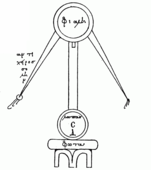Quick Facts
Biography
Cleopatra the Alchemist who likely lived during the 3rd century, was a Greek-Egyptian alchemist, author, and philosopher. She experimented with practical alchemy but is also credited as one of the four female alchemists that could produce the Philosopher's stone. She is considered to be the inventor of the Alembic, an early tool for analytic chemistry.
The dates of Cleopatra the Alchemist's life and death are unknown, but she was active in Alexandria in the 3rd century or the 4th century. She is associated with the school of alchemy typified by Mary the Jewess and Comarius. These alchemists used complex apparatus for distillation and sublimation.
Identity and misnomers
Cleopatra is a pseudonym for an author whose real name has been lost. She is not the same person as Cleopatra VII, nonetheless she may be referred to as Cleopatra: Queen of Egypt in some later works. One example of this can be found in Basillica Philosophica by Johann Daniel Mylius (1618), where her seal is pictured alongside the motto: "The divine is hidden from the people according to the wisdom of the Lord". This incorrect naming was possibly done on purpose. She is also conflated with Cleopatra the Physician. The two lived supposedly during the same time and are said to have similar styles in their writing, both having grand imagery. Cleopatra is used as a character within the dialogue of the alchemical texts themselves.
Contributions to alchemy
Cleopatra was a foundational figure in alchemy, pre-dating Zosimos of Panopolis. Michael Maier names her as one of the four women who knew how to make the philosopher's stone, along with Maria the Jewess, Medera, and Taphnutia. Cleopatra was mentioned with great respect in the Arabic encyclopedia Kitab al-Fihrist from 988. She is credited with the invention of the alembic. Also trying to quantify alchemy and its experiments, Cleopatra worked with weights and measures.
Three alchemical texts related to Cleopatra survive. The text titled A Dialogue of Cleopatra and the Philosophers exists, but cannot be attributed to her. Jack Lindsay calls this discourse "the most imaginative and deeply felt document left by the alchemist".
- Εκ των Κλεοπατρας περι μετρων και σταθμων. (On Weights and Measures)
- Κλεοπατρης χρυσοποια (Chrysopeoeia of Cleopatra)
- Διαλογος φιλοσοφων και κλεοπατρας (A Dialogue of Cleopatra and the Philosophers)
Cleopatra's use of imagery reflects conception and birth, the renewal and transformation of life. The philosopher alchemist who contemplates his work is compared to a loving mother who thinks about her child and feeds it."
Chrysopeoeia of Cleopatra
Cleopatra is most noted for the Chrysopoeia of Cleopatra (Greek: Η χρυσοποιία της Κλεοπάτρας), a single sheet of papyrus which contains only symbols, drawings and captions (all of which are pictured below). A copy can be found at Leiden University, located in the Netherlands. Chrysopoeia translated is "gold-making".
An example of the imagery is the serpent eating its own tail as a symbol of the eternal return, called the Ouroboros: a snake curving around with its head in its mouth (eating itself) is an obvious emblem of unity of the cosmos, of eternity, where the beginning is the end and the end is the beginning". Also on the Chrysopeoia is an inscription in a double ring this describing the Ouroboros:
One is the Serpent which has its poison according to two compositions, and One is All and through it is All, and by it is All, and if you have not All, All is Nothing.
Within the inscription ring is also symbols for gold, silver, and mercury. Along with those are drawings of a "dibikos" (Greek: διβικός) and an instrument similar to a kerotakis (Greek: κηροτακίς or κυροτακίς), both alchemical apparatuses. Another of her symbols is the eight-banded star. It is believed that the drawing of these star symbols and the crescent shapes above them are a pictorial depiction of turning lead into silver.
| Images from Chrysopeoia of Cleopatra | ||||||||
|---|---|---|---|---|---|---|---|---|
|




